Understanding World Societies:
Printed Page 2
Introduction for Chapter 1
1 THE EARLIEST HUMAN SOCIETIES TO 2500 B.C.E.
> How did human societies change and develop in the Paleolithic and Neolithic Eras? Chapter 1 examines early human history, tracing developments from the first humans through the emergence of settled agriculture. Human history began in Africa, where millions of years ago humans evolved from a primate ancestor. They migrated out of Africa in several waves, walking along coasts and over land, eventually spreading across much of the earth. Their tools were initially multipurpose sharpened stones and sticks, but gradually they invented more specialized tools. Environmental changes, such as the advance and retreat of the glaciers, shaped life dramatically and may have led to the most significant change in all of human history, the domestication of plants and animals.

LearningCurve
After reading the chapter, use LearningCurve to retain what you’ve read.
> CHRONOLOGY
| ca. 4.4 million years ago | ca. 15,000 B.C.E. |
| Ardipithecus evolve in Africa | Earliest evidence of bows and atlatls; humans cross the Bering Strait land bridge to the Americas |
| ca. 2.5– |
ca. 15,000– |
| Australopithecus evolve in Africa | Final retreat of glaciers; megafaunal extinctions |
| ca. 500,000– |
ca. 9000 B.C.E. |
| Homo erectus evolve and spread out of Africa | Beginning of the Neolithic; horticulture; domestication of sheep and goats |
| ca. 250,000– |
ca. 7000 B.C.E. |
| Paleolithic era | Domestication of cattle; plow agriculture |
| ca. 250,000 years ago | ca. 5500 B.C.E. |
| Homo sapiens evolve in Africa | Smelting of copper |
| ca. 30,000– |
ca. 5000 B.C.E. |
| Neanderthals flourish in Europe and western Asia | Invention of pottery wheel |
| ca. 120,000 years ago | ca. 3200 B.C.E. |
| Homo sapiens migrate out of Africa to Eurasia | Earliest known invention of writing |
| ca. 50,000 years ago | ca. 3000 B.C.E. |
| Human migration to Australia | Development of wheeled transport; beginning of bronze technology |
| ca. 20,000– |
ca. 2500 B.C.E. |
| Possible human migration from Asia to the Americas | Bronze technology becomes common in many areas; beginning of the Bronze Age |
| ca. 25,000 B.C.E. | |
| Earliest evidence of woven cloth and baskets | |
|
A note on dates: This book generally uses B.C.E. (Before the Common Era) and C.E. (Common Era) when giving dates, a system of chronology based on the Christian calendar and now used widely around the world. Scholars who study the very earliest periods of hominid and human history usually use the phrase “years ago” to date their subjects, as do astrophysicists and geologists; this is often abbreviated as B.P. (Before the Present). Because the scale of time covered in Chapter 1 is so vast, a mere 2,000 years does not make much difference, and so B.C.E. and “years ago” have similar meaning. |
|